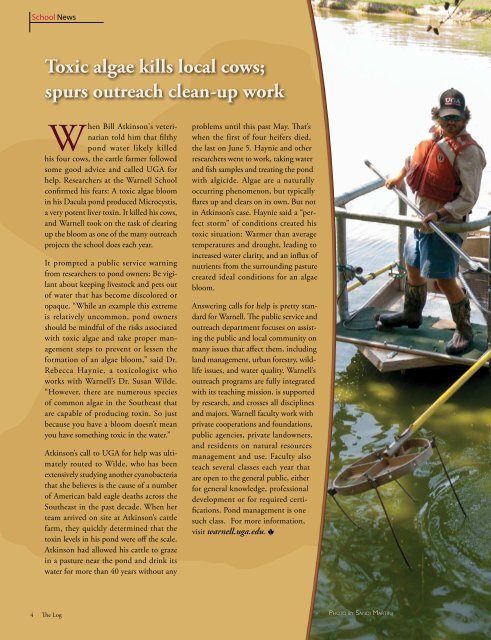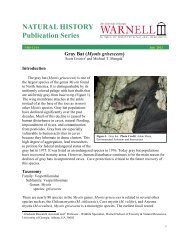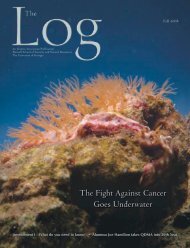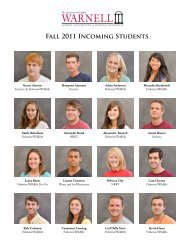Dangerous Crossings - Warnell School of Forest Resources ...
Dangerous Crossings - Warnell School of Forest Resources ...
Dangerous Crossings - Warnell School of Forest Resources ...
You also want an ePaper? Increase the reach of your titles
YUMPU automatically turns print PDFs into web optimized ePapers that Google loves.
<strong>School</strong> News<br />
Toxic algae kills local cows;<br />
spurs outreach clean-up work<br />
When Bill Atkinson’s veterinarian<br />
told him that filthy<br />
pond water likely killed<br />
his four cows, the cattle farmer followed<br />
some good advice and called UGA for<br />
help. Researchers at the <strong>Warnell</strong> <strong>School</strong><br />
confirmed his fears: A toxic algae bloom<br />
in his Dacula pond produced Microcystis,<br />
a very potent liver toxin. It killed his cows,<br />
and <strong>Warnell</strong> took on the task <strong>of</strong> clearing<br />
up the bloom as one <strong>of</strong> the many outreach<br />
projects the school does each year.<br />
It prompted a public service warning<br />
from researchers to pond owners: Be vigilant<br />
about keeping livestock and pets out<br />
<strong>of</strong> water that has become discolored or<br />
opaque. “While an example this extreme<br />
is relatively uncommon, pond owners<br />
should be mindful <strong>of</strong> the risks associated<br />
with toxic algae and take proper management<br />
steps to prevent or lessen the<br />
formation <strong>of</strong> an algae bloom,” said Dr.<br />
Rebecca Haynie, a toxicologist who<br />
works with <strong>Warnell</strong>’s Dr. Susan Wilde.<br />
“However, there are numerous species<br />
<strong>of</strong> common algae in the Southeast that<br />
are capable <strong>of</strong> producing toxin. So just<br />
because you have a bloom doesn’t mean<br />
you have something toxic in the water.”<br />
Atkinson’s call to UGA for help was ultimately<br />
routed to Wilde, who has been<br />
extensively studying another cyanobacteria<br />
that she believes is the cause <strong>of</strong> a number<br />
<strong>of</strong> American bald eagle deaths across the<br />
Southeast in the past decade. When her<br />
team arrived on site at Atkinson’s cattle<br />
farm, they quickly determined that the<br />
toxin levels in his pond were <strong>of</strong>f the scale.<br />
Atkinson had allowed his cattle to graze<br />
in a pasture near the pond and drink its<br />
water for more than 40 years without any<br />
problems until this past May. That’s<br />
when the first <strong>of</strong> four heifers died,<br />
the last on June 5. Haynie and other<br />
researchers went to work, taking water<br />
and fish samples and treating the pond<br />
with algicide. Algae are a naturally<br />
occurring phenomenon, but typically<br />
flares up and clears on its own. But not<br />
in Atkinson’s case. Haynie said a “perfect<br />
storm” <strong>of</strong> conditions created his<br />
toxic situation: Warmer than average<br />
temperatures and drought, leading to<br />
increased water clarity, and an influx <strong>of</strong><br />
nutrients from the surrounding pasture<br />
created ideal conditions for an algae<br />
bloom.<br />
Answering calls for help is pretty standard<br />
for <strong>Warnell</strong>. The public service and<br />
outreach department focuses on assisting<br />
the public and local community on<br />
many issues that affect them, including<br />
land management, urban forestry, wildlife<br />
issues, and water quality. <strong>Warnell</strong>’s<br />
outreach programs are fully integrated<br />
with its teaching mission, is supported<br />
by research, and crosses all disciplines<br />
and majors. <strong>Warnell</strong> faculty work with<br />
private cooperations and foundations,<br />
public agencies, private landowners,<br />
and residents on natural resources<br />
management and use. Faculty also<br />
teach several classes each year that<br />
are open to the general public, either<br />
for general knowledge, pr<strong>of</strong>essional<br />
development or for required certifications.<br />
Pond management is one<br />
such class. For more information,<br />
visit warnell.uga.edu.<br />
When doctoral student Sean Sterrett<br />
needed some money to pay for his<br />
research project on freshwater turtles,<br />
he ended up getting funding help from an<br />
unusual place: Complete strangers who pitched<br />
in online. Sterrett competed in the SciFund<br />
Challenge, an experiment in crowdfunding for<br />
scientific research founded by two ecologists, Jai<br />
Ranganathan and Jarrett Byrnes, to explore the<br />
possibility <strong>of</strong> individuals pooling donations to<br />
support research. Sterrett raised a total <strong>of</strong><br />
<strong>School</strong> News<br />
Unusual challenge funds<br />
dissertation research<br />
Strangers online help Ph.D. student pay for turtle project<br />
$5,688 for his dissertation research — nearly<br />
$700 more than his goal — to demonstrate that<br />
the conservation and management <strong>of</strong> freshwater<br />
turtles is significant for aquatic ecosystems.<br />
“My impetus for doing this type <strong>of</strong> fundraiser<br />
was not because I had extra time on my<br />
hands,” Sterrett said. “Over the last three years,<br />
I’ve submitted about 25 grants with very little<br />
success. Needless to say, it’s becoming much<br />
tougher to find even small pools <strong>of</strong> money for<br />
research when funding is decreasing, and there<br />
are so many people needing it.” As part <strong>of</strong><br />
the challenge, Sterrett included details about<br />
his dissertation and created a video that discussed<br />
how freshwater turtles contribute to<br />
an aquatic system’s health. Sterrett’s project<br />
involves estimating densities <strong>of</strong> the turtles<br />
and assessing their diets using natural tracers<br />
and fecal samples. He then plans to determine<br />
which types <strong>of</strong> nutrients — and at<br />
what rate — are redistributed into habitats<br />
through turtle waste.<br />
“I enjoyed putting together the proposal,”<br />
Sterrett said. “Filming and editing the<br />
movie was especially novel for me and<br />
I enjoyed the creativity that it <strong>of</strong>fered.<br />
After the proposal and movie were all<br />
done, I was only half way through the<br />
battle. Most <strong>of</strong> the work went into<br />
promoting my site and why I needed<br />
money. Overall, it was an incredible<br />
success. I raised the most money <strong>of</strong><br />
75 scientists across the world. I can’t<br />
say enough about the generosity<br />
<strong>of</strong> complete strangers, colleagues,<br />
friends and family.”<br />
4 The Log<br />
Photo by Sandi Martinj<br />
Photo courteSy <strong>of</strong> Sean Sterrett<br />
illuStration by Wade neWbury<br />
Fall 2012 5





